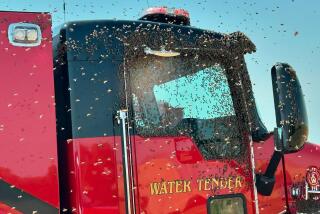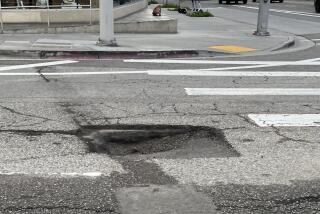What’s behind spots on autos?
- Share via
Question: I am looking to the L.A. Times for help in trying to find out what is causing the orange/yellowish spots that are appearing on our cars in increasing numbers. I have lived here for 24 years and have owned white cars for all of that time. In the past four or five years I have noticed dark orange/yellow droppings on my car, about the size of a pencil eraser. Within the last two years they have increased in number. Once dried, it is very difficult to get them off.
Pat Hiett
Mission Viejo
Answer: Almost everybody I know has those yellow spots on their cars, though the wildfires this past week have created a more urgent and more serious problem for car paint.
I had always assumed the yellow spots were some kind of vile condensation of Southern California smog -- a combination of carcinogens from a Carson oil refinery, out-gassing from a plastics factory, a pinch of diesel soot from the port, and the entire concoction held together with a salty Pacific Ocean mist.
I feared those yellow spots were burning holes right through my clear coat and eating into the sheet metal like a titanium drill bit. And yes, they don’t easily wash off. I’ve been tempted to use a Brillo pad, but I never reached that level of desperation.
To solve this mystery I went to a couple of auto body experts, all of whom had seen the yellow spots, but nobody in the paint business could offer an authoritative answer to what or who caused them. Everybody, however, seems to agree that they fall from the sky.
So I went to the superagency that manages our air, the South Coast Air Quality Management District. The scientists at AQMD are on top of this one. They have seen the yellow spots, collected samples, put them under a microscope and have concluded they are bee pollen, said agency spokeswoman Tina Cherry.
I wondered why bees would drop their pollen, when they should be carrying it back to the hive to make honey. AQMD’s explanation seemed close but not quite correct. Susan Cobey, a research associate at the UC Davis bee laboratory, said it is not pollen but bee poop -- or more politely, digested pollen.
“The bees mix the pollen with a little bit of honey and put it in a basket on their legs, so it is in there pretty securely and doesn’t fall out,” Cobey said.
However, bees follow certain regular flight lines, so parking your car under one of these high traffic bee routes can make for a big mess from bees dropping their waste, which they do more often at certain times of the year, particularly in the spring.
The bee droppings are acidic, but Cobey isn’t sure how they affect car paint. She finds that if she wets down her car and lets it set, the bee droppings dissolve and can be washed away.
Bad things’ falling from the sky is a timely issue, given the thick layer of smoke and soot created by the wildfires across the region. It is highly alkaline and very abrasive, according to the Auto Club and other experts.
The club advises garaging cars until the air clears and quickly washing ash off cars.
Meguiar’s Inc., an Irvine-based producer of car care products, said the soot and smoke contain chemicals that can eat into the finish. They include calcium, potassium, phosphorus and magnesium. The potassium can form potassium hydroxide, the main ingredient in drain cleaner, said Gary Silvers, vice president for research and development at Meguiar’s.
A number of experts say it is vital to get the soot and ash off cars as quickly as possible. In some cases, experts advise blowing it off before wetting it down. A more conventional approach is to completely flush the car with water, use a good automotive soap and a washing mitt that will not grind the ash into the paint.
One last bit of advice is to check your air filter and possibly replace it. The crud has no doubt accumulated in the filters. If it is highly abrasive to paint, it is equally damaging to moving parts in your engine. Many motorists frequently change their oil and oil filters, but ignore air filters. The two go hand in hand in keeping the inside of engines clean.
I’ll take the bee poop over ash any day.
Cobey said we should all celebrate bee droppings on our cars. Bee populations are reportedly declining due to pollution, mite infestations and the loss of wildflowers that they need. Bee poop shows that bees are still alive in our neighborhoods.
--
More to Read
Sign up for Essential California
The most important California stories and recommendations in your inbox every morning.
You may occasionally receive promotional content from the Los Angeles Times.











